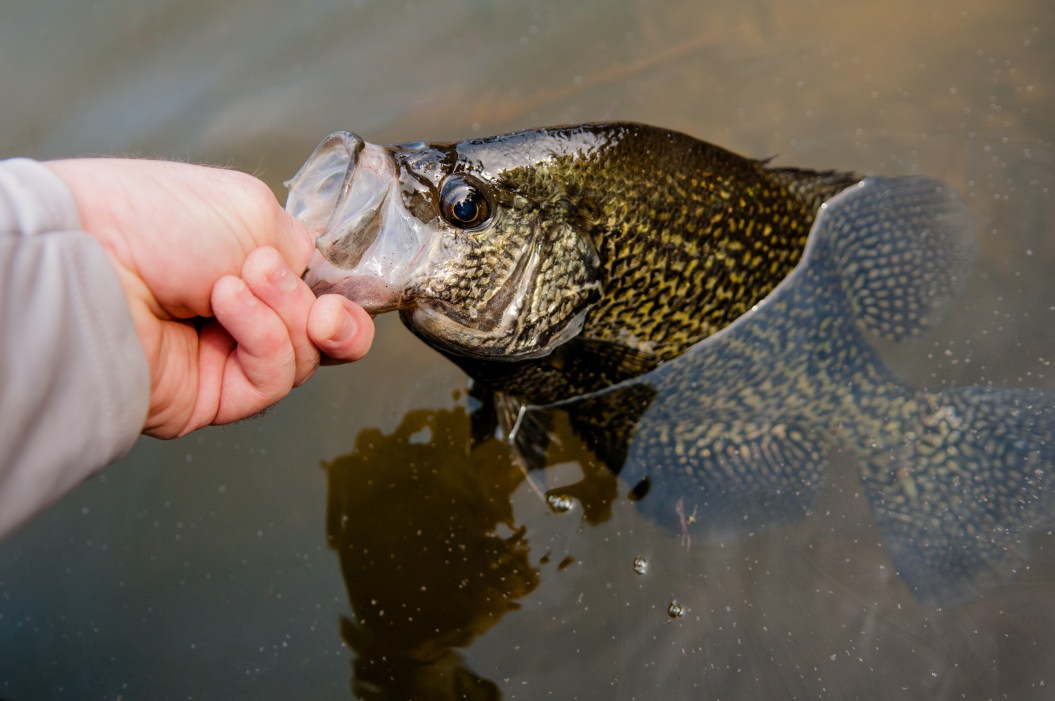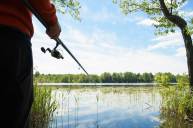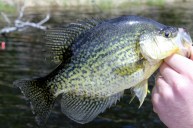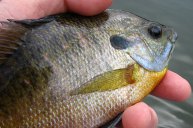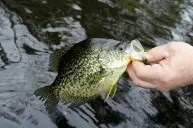One of the quintessential gamefish, crappie are the largest members of the Centrarchidae family. Anglers hooked by the crappie bug love both black crappie (Pomoxis nigromaculatus) and white crappie (Pomoxis annularis) so much that they spend many hours, days, and even years thinking up the best ways to catch them. An excellent eating fish thanks to its delicate, flaky meat, crappie often run 7 inches to a foot long and commonly weigh a half-pound to a pound. They put up a hard fight for their size, which helps put them high on anglers' fishing lists.
Black and white crappie are similar to each other, with a few distinct differences. Black crappie, sometimes called "specks," are speckled throughout the length of their body and have seven or eight spines. Conversely, white crappie have vertical bars—not speckles—running down the sides of their body, and only five or six spines. The black crappie also has a larger mouth and somewhat resembles a largemouth bass. (Read more about the differences between the two species here.)
Why We Love Fishing for Crappie
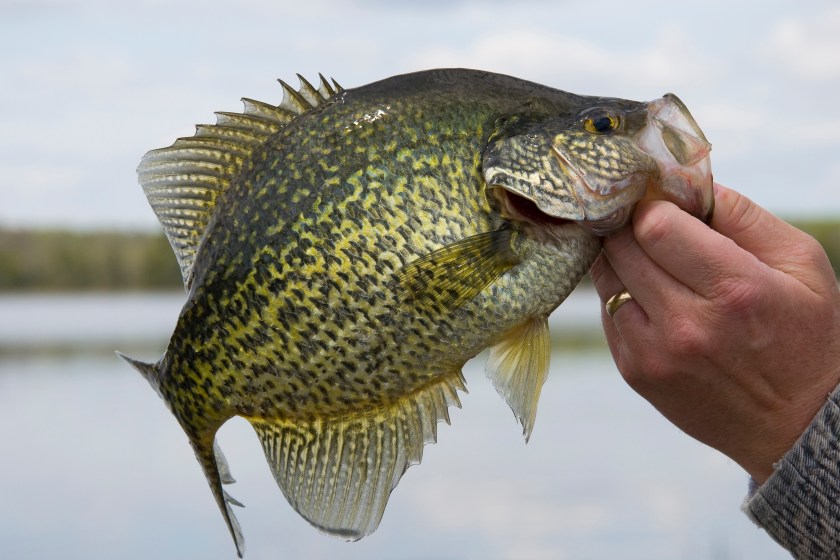
Getty Images, SteveOehlenschlager
As a career angler, I've been lucky enough to fish for both black and white crappie in several different lakes and rivers, and these special fish remain one of my favorites. They're not overly selective of what they eat; they punch well above their weight once hooked; and—should you choose to not release them—they're an excellent eating fish. While not as trendy on social media or as glorified as other species, crappie are well worth the time to target.
For Josh Mills, a development coordinator for Backcountry Hunters & Anglers, as well as a passionate angler, crappie are a special reminder of what fishing is all about. "Crappie remind me what brought me to a love of fishing," he says. "It's memories like the first time my dad took me out to fish the dock lights at Deer Lake. It's the feeling of being proud to turn those fish into dinner. It's their willingness to be a dance partner and the simplicity of what it took to hook them. I went years without targeting them, as I had focused all my time on the sexier species out there. Upon returning with a 3-weight fly rod, some simple leech patterns, and a bobber, I was awash once again awash in fond memories and happiness—and great meals ahead with my wife and children."
Crappie Facts, Distribution, and Habitat
Both white and black crappie are less active during the day, and anglers will have better luck fishing in the early morning or evening hours. Crappie travel in schools. If you hook into one, hang around and work that same section of water; its friends are likely in the same area. White crappie tend to favor murkier water, while black crappie prefer cleaner, clear waters in lakes, rivers, reservoirs, and ponds. Native to Canada and the eastern U.S., crappie are now a popular gamefish in the Mississippi River, Hudson Bay, and Great Lakes Basin.
Crappie spawn in the early spring into the early summer when water temperatures hit 62-68 degrees Fahrenheit. Typically, the spawn lasts three weeks, as male crappie build a nest on the bottom in shallow water and then guard the same nest after the female lays her eggs. The female lays anywhere from 5,000 to 10,000 eggs at once, and these eggs then take two to five days to hatch.
Crappie can be fished a variety of ways, the details of which we'll get into below. Depending on the environment, the season, and the size of the individual fish, their diet includes crustaceans, small fish and minnows, insects, larvae, and zooplankton.
How to Find Crappie
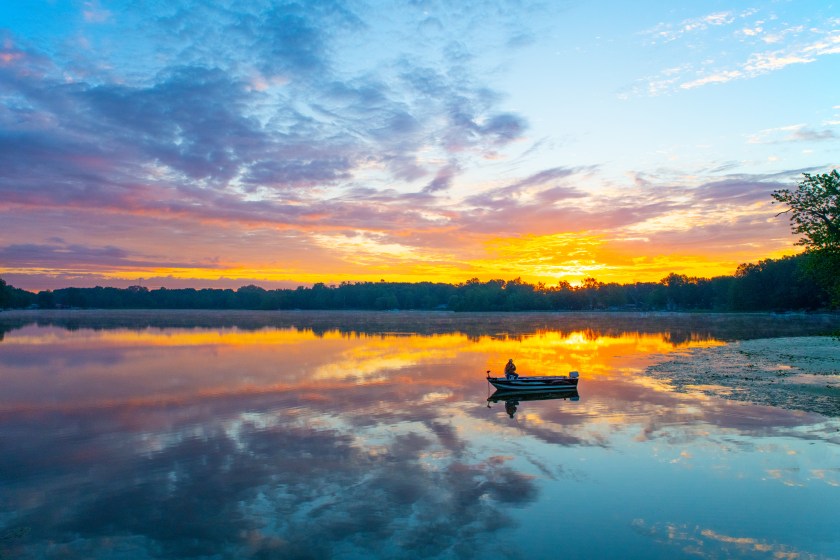
Getty Images, William Reagan
1. Target Shallow Water, Slack Pools, and Vegetative Cover.
Crappie tend to prefer shallow waters or slack pools and seek out good cover in the form of vegetation or structure. If you can find a good clump of cattail, a solid brush pile, old stumps, sunken trees and limbs, or other sturdy, dense cover and vegetation, it's a good start toward your best crappie fishing.
2. Fish Near Shore
Fishing near shore can be very productive, as there tends to be more structure along shorelines. This hard cover can make fishing challenging, and anglers have to be careful to not tangle their lines—but usually, structure fishing pays off.
3. Look for Cool Water
As the summer goes on and the water warms, crappie head for deeper, cooler water. They will push toward the shallower water along the shore in the early morning and late evening hours to feed, then retreat back into deeper waters. Even when fishing deeper water, look for structure on the bottom of the lake in the form of weed beds, downed timber, mounds, or other "texture."
How to Fish For Crappie
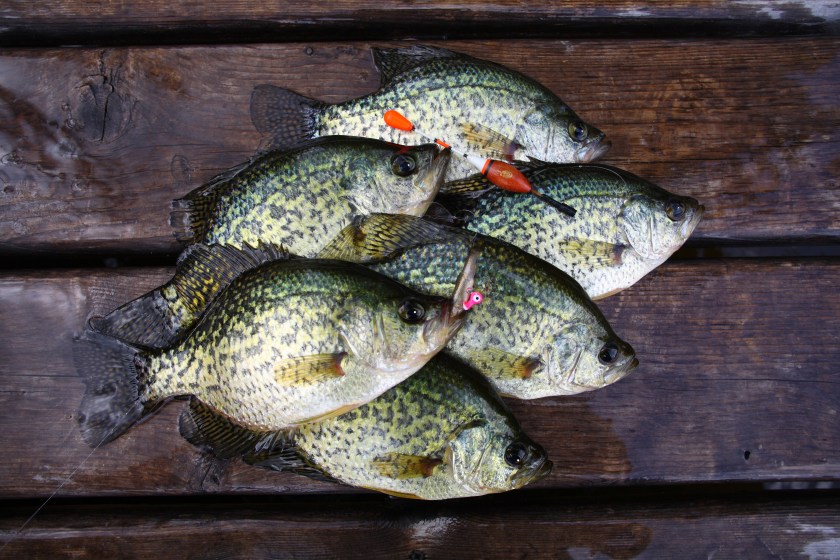
One of the amazing things about crappie is you can catch them in so many ways. With a little bit of practice, you can perfect each method and become a crappie-catching master.
1 of 5: With Lures and Artificial Bait
Perhaps the most popular way to fish for big crappie is with artificial bait. Small lures such as jigs or crappie spinners are great for dredging deep down in lakes or for working along structure. Ultralight spinning rods and reels are commonly used to catch crappie, paired with anything from lightweight 2-pound test monofilament or fluorocarbon all the way up to 30-pound braid for pulling fish from dense structure or deep, rough water.
When fishing lures and artificial baitfish, anglers should cast out and then retrieve the line back, hoping to entice the fish to bite on the retrieval. Pay careful attention to selection of your lure: The right size, color, and manner of retrieval all factor into a successful day on the water. Try to match your lure to the bait naturally occurring in the water—the closer it looks to the natural prey, the higher the odds for a successful hook-up.
Crankbait is also a favored way to fish for crappie. Ideal for targeting fish suspended higher or midway in the water column, crankbaits entice a fish to strike violently—and make for very fun fishing. Troll through schools of fish with a mid-sized, medium-diving crankbait and watch the fish go wild. Multiple rods can be used to troll lakes in this manner, providing entertainment and productive fishing for several anglers at once.
2 of 5: With Live Bait and Minnows
Fishing for crappie with live minnows and other live bait is perhaps one of the most traditional—and fun—ways to pursue fish. Classic and yet very effective, using worms and minnows can be productive for crappie fishing in a variety of situations. In the "good old days," fishers simply rigged a cane pole with some string, a hook, and a worm. While technology has changed, the ideas remain the same.
It's still hard to beat the combination of a minnow or a worm underneath a bobber. This is straightforward and familiar for many anglers. Secure a bobber a few feet above a minnow on a No. 1 or No. 2 hook. The minnow can be allowed to swim freely, or split shot can be added to pull the bait deeper into the water column and help prevent it from swimming into cover.
When fishing with live bait, consider spider rigging. This method allows anglers to fish or troll several baits or lures, increasing the odds of hooking into fish. (Editor's note: Be sure to check local regulations to see how many rods you're allowed to fish at one time.) The more bait in the water, the greater the odds. A heavy (0.5- to 1-ounce) sinker is used at the end of each line to pull the bait deep into the target water and keep it down even in rough water, and each line can use one or multiple hooks. (The name "spider rigging" comes from each rod being a leg of the metaphorical spider.)
3 of 5: With a Jig
Another favored way to chase crappie, jig fishing is preferred by many anglers throughout the Midwest. Again, look to cast your jigs alongside structure or good cover, which is where the fish will be hiding. Crappie are a diverse fish and live in diverse areas; so if you like to throw jigs, find water well-suited to jig fishing and go from there. Especially if you're looking to catch enough crappie to feed yourself and friends, a combination of jig fishing with good, old-fashioned minnow angling can be the way to go.
Because jigs can be used in a variety of ways in a variety of situations, they are a good choice for crappie anglers. Casting your jig out and then vertical jigging for presentation to the fish can be very productive in deeper water. Fishing shallower waters near structure is often most productive with a cast and quick retrieve for a more-active, horizontal presentation to entice the fish to strike. Jigs can also be dropped into deep water alongside structure and left to "dangle" until a fish bites.
"Shooting," or skipping, is another active jig fishing method to catch crappie. The angler loads the rod and launches the jig forward, shooting or skipping it underneath low or tight cover. This is a tried-and-true technique to reach difficult areas and access water that otherwise would be impossible to fish. As discussed, crappie love cover; and if you can shoot a jig underneath tight or dense cover, the odds are good you're going to find some promising fishing.
If you want to focus on any of these jig fishing techniques, look for a 6-to-7-foot, medium-action rod loaded with 4-to-6-pound fluorocarbon line.
4 of 5: Fly Fishing
While crappie are not high on the bucket list for many fly anglers, they are a worthwhile target on the fly. Depending on the water, conditions, and time of year, dry flies, streamers, and nymphs can all work well. Reach for your dry flies on calm days, especially when fishing early and late when the fish are in shallower water close to shore (small ants and other terrestrial patterns are a good place to start). If you're fishing midday or in deeper waters, tie on nymphs, large soft hackles, or small streamers (it's hard to go wrong with a small black Woolly Bugger or a Clouser Minnow).
The same location tenets hold true: Whichever flies you're fishing, target around good structure and cover. Fly fishing works best in shallower water (think 5 feet or less), unless you're fishing a sink-tip or full-sink line, in which case you can delve into deeper waters.
5 of 5: From the Bank
Fishing for crappie is most often done from a boat, but it's very possible to target crappie while fishing from the bank. As crappie tend to favor shallower water during the dawn and dusk hours, these are going to be the most productive times to fish from the bank. Seek out cover including trees, branches, brush, and other structure that provides protection for the fish. Boat ramps, bridges, pilings, and other man-made structures can also be an excellent starting spot for finding schools of fish aggregating around cover.
Fishing from the shoreline can also be more successful in the winter months, when crappie will often congregate around structure in dense schools. Target all sides of the structure, varying the depth of your bait or lure until you sweep through the school. In cold water, many anglers find that small minnows can be more productive than jigs or other artificial lures.
However you choose to pursue crappie, don't write off this humble fish as something to be ignored. Crappie offer an excellent fight, especially relative to their size, and provide an excellent way for new anglers to get into the rhythm of catching and managing fish. They're also one of the best eating fish found in fresh water; so if you're in the mood to get a group of friends or family together for a fishing trip, camping excursion, and a fish fry, crappie might just be on the menu! So rig up, head to the nearest body of water, and get ready for your best fishing of the season, all thanks to the humble crappie.
READ MORE: How to Swing a Wet Fly For Trout
